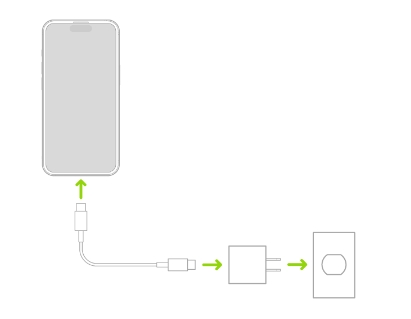Hot Topics
 by Maggie Mueller
Updated On Oct 23, 2024
Published On Oct 23, 2024
Basic iPhone Tips Ideal for Newbies
by Maggie Mueller
Updated On Oct 23, 2024
Published On Oct 23, 2024
Basic iPhone Tips Ideal for Newbies
When booting up your iPhone, you may notice that it takes an unusually long time to complete the startup process. The Apple logo might flash repeatedly on your screen, which can be alarming. However, there's no need to panic; your iPhone is not permanently dead yet.
In this article, we will explore various possible solutions to resolve the issue of the "iPhone keeps blinking or flashing Apple logo." The solutions range from simple fixes like restarting your device to more comprehensive measures like restoring the operating system to a previous state.
Before diving into the solutions, let's briefly review the potential reasons why you might be experiencing this problem.
Software Glitches: The software may not install properly when you update your iOS or restore your iPhone, leading to system errors.
Malicious Apps: Installing apps from untrusted developers can create conflicts in the system, which might result in the flashing Apple logo.
Battery Problems: If your iPhone's battery is completely drained, it may lack the power needed to boot up.
Hardware Damage: If your phone has been dropped or exposed to water, internal components may have suffered damage, which can prevent your iPhone from powering on.
If your iPhone is blinking the Apple logo after using iTunes to update or restore, the issue might lie in the data transfer process between your iPhone and computer. Sometimes, defective USB cables or ports can disrupt this transfer, leading to software corruption.
To resolve this, check your USB cable and port. Try to use a different USB cable or try connecting your iPhone to another USB port on your computer. If you're using a PC and can't identify the issue, consider using a friend's computer for the restoration process.

Before moving forward, try charging your iPhone by plugging it into a power source and leave it for at least 30 minutes. After a few minutes, you should see the "charging" screen. If not, check that you're using a good USB cable and adapter, and ensure the ports are free of dust or debris.

If your iPhone is still stuck on the flashing Apple logo after charging, one of the simplest solutions is to perform a force restart. This action attempts to boot your iPhone again and can often clear minor system errors.
The process for force restarting your device varies depending on your iPhone model. Be sure to follow the steps specific to your device:
For iPhone 8 and Newer: Press and quickly release the volume up button, then the volume down button. After that, press and hold the side button until you see the Apple logo again.

For iPhone 7 Series: Press and hold both the volume down button and the power button simultaneously. Keep holding until the Apple logo appears.

For iPhone 6 and Older: Press and hold both the Home button and the power button at the same time. Keep holding until the screen goes black and the Apple logo appears.

As you can see, force restarting your iPhone is easy.If the problem persists and your device is still blinking the Apple logo, continue to the next solution below.
A forced restart can eliminate simple system errors, but oftentimes, a much deeper software problem can cause the problem to persist. Fortunately, there is a solution that you can use to repair the iOS system by yourself in just 30 minutes.
This solution is TinyFix iOS system repair program which is designed for non-techies to eliminate these issues including iPhone blinking Apple logo without causing data loss.
The program's key features include the following:
To use TinyFix to fix a device that keeps flashing the Apple logo without losing data, follow these simple steps::
Step 1. Install and launch TinyFix on your Windows or macOS computer.
Step 2. On TinyFix, select the iOS System Repair button.

Step 3. You can choose between two repair modes. For our case, choose Standard Repair Mode.

Step 4. Connect your iPhone to your PC via a USB cable.

Step 5. Press the Download button to download the firmware to repair the iOS.

Step 6. Once the download is finished, click the Fix Now button.

Note: Ensure that your iPhone remains connected to your PC throughout the entire process. A disconnection can lead to additional errors and data corruption, so make sure the cable is securely connected.
If you want to troubleshoot the issue yourself, you can restore your iPhone using iTunes or Finder. Here's how to do it:

Another method to resolve the flashing Apple logo issue is to restore your iPhone using Recovery Mode. This process works when your iPhone can't be recognized by the computer and also requires connecting your iPhone to a Windows or macOS computer and using either the Finder app or the iTunes app.
Here's how to restore your iPhone in Recovery Mode:
Step 1. Connect your iPhone to your computer using a USB cable.
Step 2. Depending on your iPhone model, follow these button sequences to enter Recovery Mode:
iPhone 8 or later: Press and release the volume up button. Then, press and release the volume down button. Finally, press and hold the side button. After a while, you should see the Recovery Mode screen.

iPhone 7 Series: Press and hold the top/side button and volume down button together until you see the Recovery Mode screen.

iPhone 6 or older: Press and hold the Home button and the top/side button together until you see the Recovery Mode screen.

Step 3. After entering Recovery Mode, Finder or iTunes should detect your device and prompt you to Update or Restore. Choose Restore.

Step 4. When prompted, choose Restore and Update. Note that this will erase your data, so ensure you have a backup available.

Once the process is complete, set up your device. It's essential that your iPhone stays connected to your computer throughout the process to avoid further data corruption. If the Apple logo continues to flash when your iPhone restarts, consider the next option.
DFU (Device Firmware Update) Mode can also be used to erase and restore your iPhone. This method is typically reserved for situations where entering Recovery Mode does not resolve the issue, so it should generally be seen as a last resort. It is important to note that you should avoid using DFU Mode if your device has experienced any form of physical or liquid damage.
Entering DFU Mode varies based on your iPhone model. Here's how to do it:
Step 1. Connect your iPhone to your computer and open iTunes or Finder.
Step 2. Follow the steps below depending on your iPhone model:
iPhone 6 Series and Older:
iPhone 7 Series:
iPhone 8 Series and Newer:

If you're unable to fix the issue yourself, or if you've tried all the methods outlined above and your iPhone still displays the flashing Apple logo, you can get professional help from Apple. If your device is still under warranty, you may be eligible for a repair or replacement at no cost. However, if it's out of warranty, you might incur charges for repairs.
They offer repairs at the Genius Bar in their stores or through an online mail-in service. Here are your options:

The iPhone blinking Apple logo can be challenging to fix, especially since the device is unresponsive to your attempts to fix it. The solutions we've discussed should help if the issue is software-related. However, hardware problems are more complex and usually require the expertise of a professional technician.
Your feedback is valuable to us. If you have any questions regarding this topic or would like further clarification on any of the solutions provided, please let us know in the comments section below. We're here to help!
